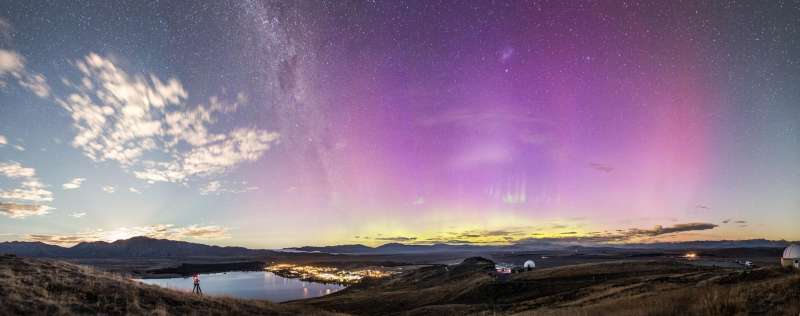
|
Credit & Copyright: David Weir
(Earth and Sky Ltd.)
Explanation:
Sometimes the more you look at an image, the more you see.
Such may be the case for
this beautiful nighttime panorama taken last week in
New Zealand.
Visible right off, on the far left, are common clouds, slightly altered by the digital
fusion of combining 11 separate 20-second exposures.
More striking, perhaps, is the broad
pink aurora that dominates the right part of the image,
a less common auroral color that is likely tinted by excited
oxygen atoms high in Earth's atmosphere.
Keep looking and you might notice a bright light just beyond the mountain on the
left.
That is the
rising Moon -- and an even closer look will reveal faint
crepuscular rays emanating
from it.
Musing over the image center may cause you to notice the
central band of the
Milky Way Galaxy which
here appears to divide, almost vertically, the left clouds from the right aurora.
Inspecting the upper right of the image reveals a fuzzy patch, high in the sky, that
is the
Small Magellanic Cloud.
Numerous stars discretely populate the distant background.
Back on Earth, the image foreground features two domes of the
Mt. John University Observatory and a camera tripod looking to
capture much of this scene
over a serene
Lake Tekapo.
|
January February March April May June July August September October November December |
| ||||||||||||||||||||||||||||||||||||||||||||||||
NASA Web Site Statements, Warnings, and Disclaimers
NASA Official: Jay Norris. Specific rights apply.
A service of: LHEA at NASA / GSFC
& Michigan Tech. U.
Based on Astronomy Picture
Of the Day
Publications with keywords: aurora - New Zealand - SMC
Publications with words: aurora - New Zealand - SMC
See also:
- APOD: 2025 January 7 Á A New Years Aurora and SAR Arc
- APOD: 2024 December 8 Á Aurora around Saturns North Pole
- APOD: 2024 October 16 Á Colorful Aurora over New Zealand
- APOD: 2024 October 13 Á Aurora Timelapse Over Italian Alps
- Northern Lights, West Virginia
- Aurora Australis and the International Space Station
- APOD: 2024 June 26 Á Timelapse: Aurora, SAR, and the Milky Way
